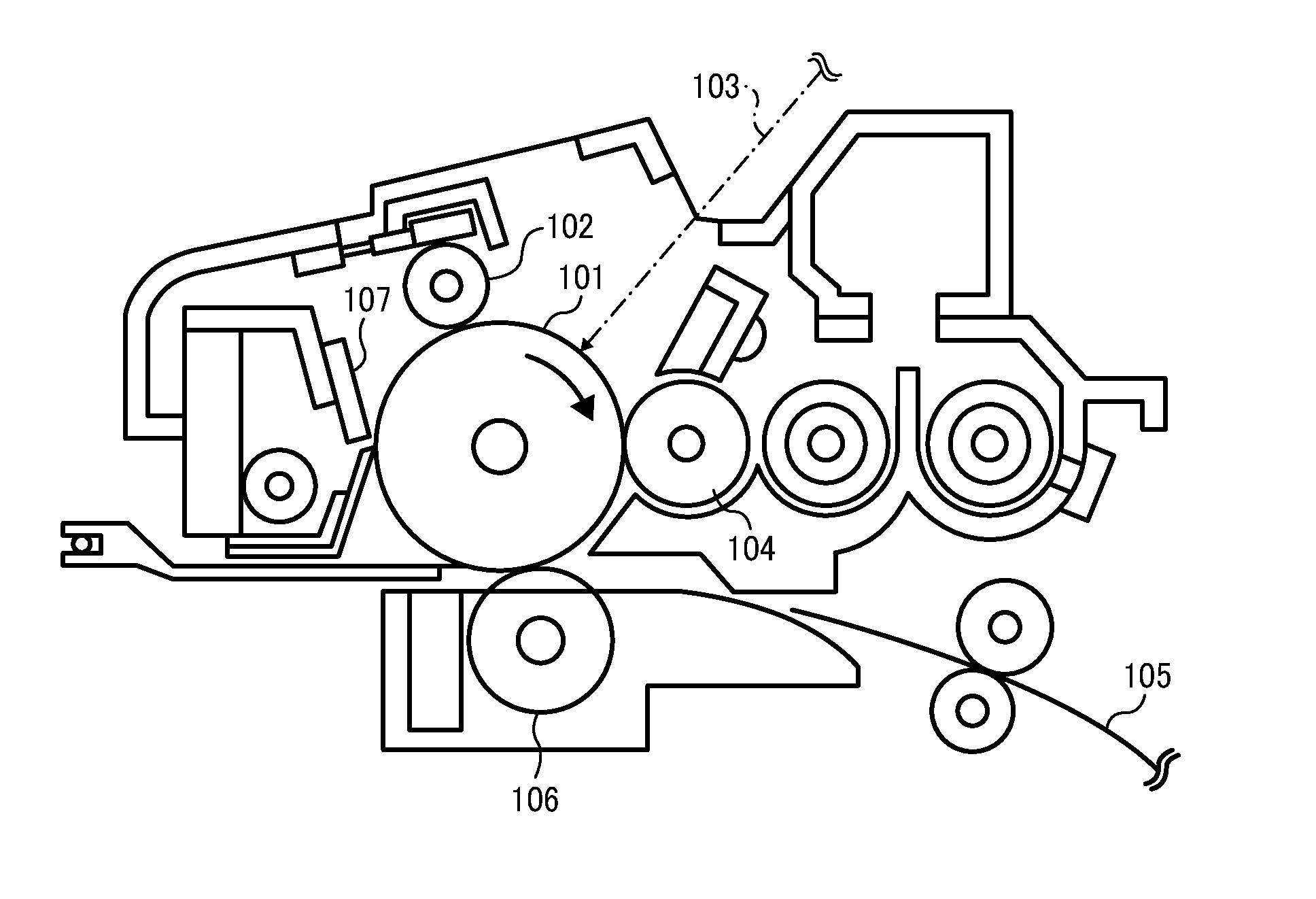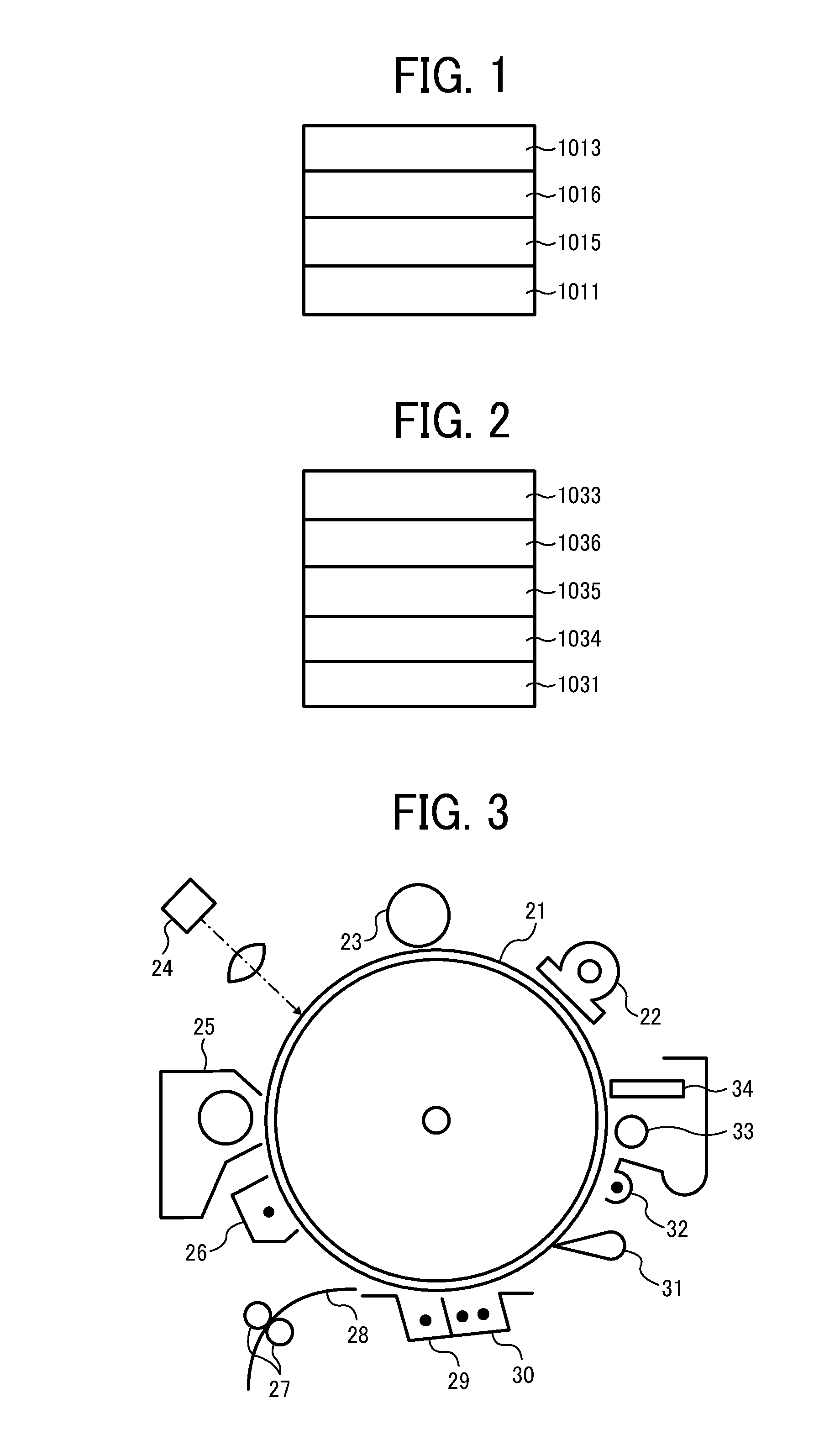Among these technologies, the technology of using a curable binder improves abrasion resistance and damage resistance due to the curing but is not sufficient in the conditions of the quick printing field which is severer than those of the typical printing in office environments.
In addition, promotion of curing reaction to improve the
hardness of a surface layer leads to a significant rise of the
residual voltage and prevents a good combination of the
mechanical strength and electrostatic durability.
The technology of using a charge transport
polymer improves anti-abrasion property in some degree but is not good enough for use in the quick printing field.
In addition,
polymerization and refinement of such a charge transport
polymer is difficult and thus the charge transport
polymer having a high purity is not easy to obtain.
Therefore, this technology is not good enough in terms of the electrostatic durability.
Furthermore, there are manufacturing problems such that the liquid application has a high
viscosity.
The technology with regard to filler dispersion improves the abrasion resistance but again is not sufficient in the quick printing field.
The
mechanical strength is improved by containing a filler but detached filler may damage the surface of the image bearing member, which may lead to occurrence of filming or attachment of foreign objects as the damage develops.
As described above, these typical technologies improve the abrasion resistance of an image bearing member but cause electrostatic deterioration, which results in the occurrence of image deficiency, etc.
Thus, these technologies are not sufficient in application use in the quick printing field.
However, when a material not involved in the curing reaction of the cured resin is mixed, such a material inhibits curing reaction, in which case such effects are not obtained.
Therefore, a method in which a filler is contained in a cured resin is anticipated to have a great effect but is extremely difficult to realize.
For example, there is a problem with the dispersion property of a filler.
Such known technologies are not good enough because the effect of the cured resin is not obtained when curing reaction is inhibited.
However, a
single use of this method is insufficient.
As described above, the
protection layer in which a filler is dispersed in a cured resin is an extremely efficient way to improve the abrasion resistance of an image bearing member but there are a number of problems to be solved to obtain such effects.
However, when a
protection layer formed of a filler and a cured resin is formed on a photosensitive layer (or charge transport layer), the curing reaction of a curable resin may be inhibited due to the existence of the filler.
However, when a filler having a bad dispersion property is used and thus agglomerates, the curing reaction is significantly inhibited and thus the filler is not sufficiently held in the cured resin.
In addition, when the filler agglomerates and is not sufficiently dispersed, the number of fillers with thinly covered by the resin increases and thus the filler tends to be detached therefrom.
Thereby, the abrasion resistance of the image bearing member significantly deteriorates.
Furthermore, when the resin is not sufficiently cured by the curing inhibition, the damage resistance of the image bearing member deteriorates.
In this case, when the filer is easy to be detached from the resin due to the decreased retaining power of the filler, the detached filler further damages the surface of the image bearing member, which accelerates deterioration of abrasion resistance and damage resistance.
These create problems of image deficiencies in a spot manner, bad cleaning performance, etc.
As a result, locally abraded portions and electrostatic deterioration occur and images having image deficiency in aspot manner and / or uneven
image density are produced.
When a charge transport material contained in the photosensitive layer is dissolved in a
solvent contained in a liquid application of the protection layer during formation of the protection layer on the photosensitive layer, the charge transport material elutes into the protection layer and the eluted charge transport material may causes curing inhibition.
However, when an extremely large amount of the charge transport material elutes into the protection layer, curing is significantly inhibited, which results in significant deterioration of abrasion resistance and damage resistance.
However, an
elution amount that is excessively large tends to cause image blur and reduction in resolution in an oxidizing gas
atmosphere, which may lead to significant degradation in the
image quality.
This leads to side effects such as
wrinkle or
cracking in the protection layer or peeling-off thereof because the attachment force to the
photosensitivity decreases.
Thus these are not suitable solutions.
However, it is extremely difficult to have a good combination of these.
This is because a preferable
solvent for dispersion of the filler does not necessarily match a
solvent that adequately limits the
elution amount of the charge transport material in the photosensitive layer
When a liquid application for the protection layer contains a large amount of a solvent in which the charge transport material is insoluble, the charge transport material hardly elutes into the protection layer, which may cause peeling off of the protection layer and
precipitation of the charge transport material.
 Login to View More
Login to View More  Login to View More
Login to View More 


